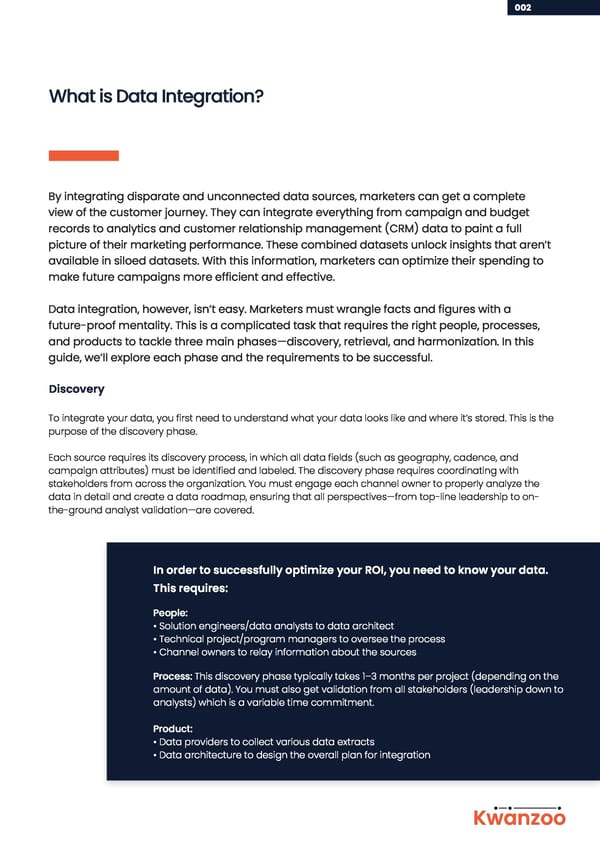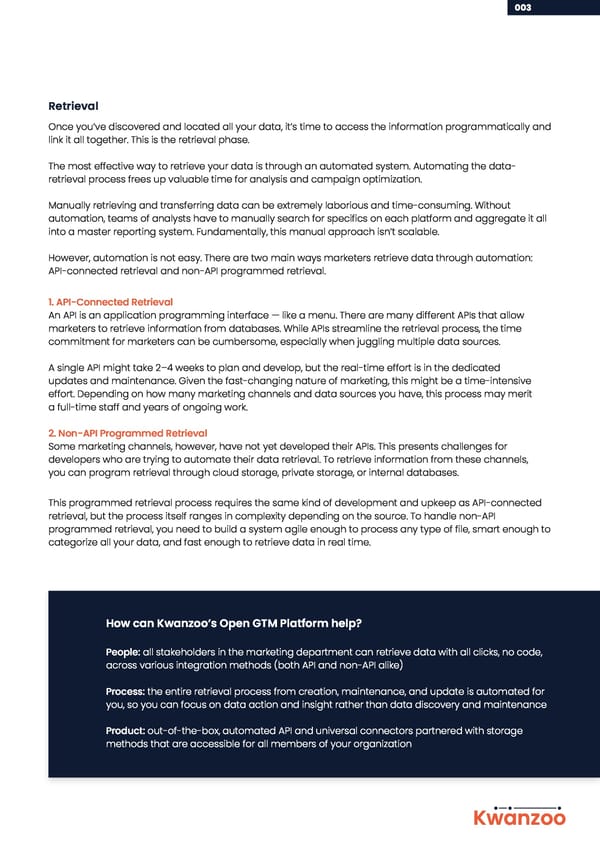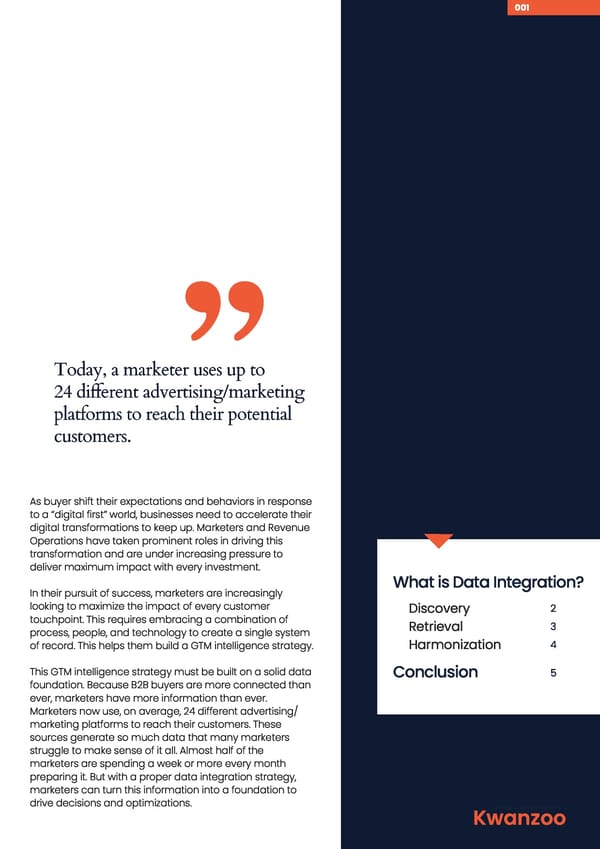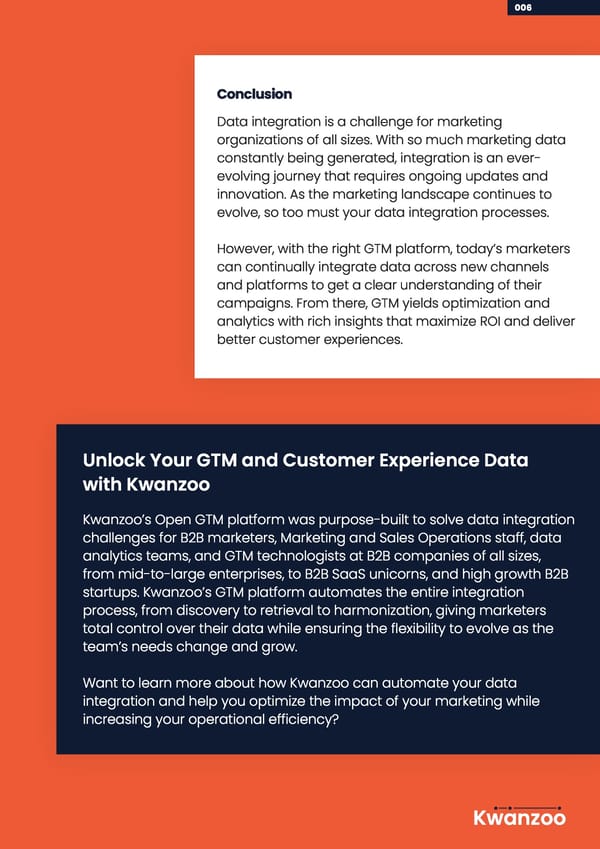3. Go-to-Market Data Integration Playbook
Kwanzoo Go-to-Market Data Integration Playbook Unifying your Marketing, Sales and Customer Success Data for In-Depth Analysis. KK

001 TTooddaayy,, aa mmaarrkkeetteerr uusseess uupp ttoo 2244 ddiiffffeerreenntt aaddvveerrttiissiinngg//mmaarrkkeettiinngg ppllaattffoorrmmss ttoo rreeaacchh tthheeiirr ppootteennttiiaall ” ccuussttoommeerrss.. As buyer shift their expectations and behaviors in response to a “digital first” world, businesses need to accelerate their digital transformations to keep up. Marketers and Revenue Operations have taken prominent roles in driving this transformation and are under increasing pressure to deliver maximum impact with every investment. What is Data Integration? In their pursuit of success, marketers are increasingly looking to maximize the impact of every customer 2 Discovery touchpoint. This requires embracing a combination of 3 Retrieval process, people, and technology to create a single system 4 of record. This helps them build a GTM intelligence strategy. Harmonization This GTM intelligence strategy must be built on a solid data 5 Conclusion foundation. Because B2B buyers are more connected than ever, marketers have more information than ever. Marketers now use, on average, 24 different advertising/ marketing platforms to reach their customers. These sources generate so much data that many marketers struggle to make sense of it all. Almost half of the marketers are spending a week or more every month preparing it. But with a proper data integration strategy, marketers can turn this information into a foundation to drive decisions and optimizations. Kwanzoo
002 What is Data Integration? By integrating disparate and unconnected data sources, marketers can get a complete view of the customer journey. They can integrate everything from campaign and budget records to analytics and customer relationship management (CRM) data to paint a full picture of their marketing performance. These combined datasets unlock insights that aren’t available in siloed datasets. With this information, marketers can optimize their spending to make future campaigns more efficient and effective. Data integration, however, isn’t easy. Marketers must wrangle facts and figures with a future-proof mentality. This is a complicated task that requires the right people, processes, and products to tackle three main phases—discovery, retrieval, and harmonization. In this guide, we’ll explore each phase and the requirements to be successful. Discovery To integrate your data, you first need to understand what your data looks like and where it’s stored. This is the purpose of the discovery phase. Each source requires its discovery process, in which all data fields (such as geography, cadence, and campaign attributes) must be identified and labeled. The discovery phase requires coordinating with stakeholders from across the organization. You must engage each channel owner to properly analyze the data in detail and create a data roadmap, ensuring that all perspectives—from top-line leadership to on- the-ground analyst validation—are covered. In order to successfully optimize your ROI, you need to know your data. This requires: People: • Solution engineers/data analysts to data architect • Technical project/program managers to oversee the process • Channel owners to relay information about the sources Process: This discovery phase typically takes 1–3 months per project (depending on the amount of data). You must also get validation from all stakeholders (leadership down to analysts) which is a variable time commitment. Product: • Data providers to collect various data extracts • Data architecture to design the overall plan for integration Kwanzoo

003 Retrieval Once you’ve discovered and located all your data, it’s time to access the information programmatically and link it all together. This is the retrieval phase. The most effective way to retrieve your data is through an automated system. Automating the data- retrieval process frees up valuable time for analysis and campaign optimization. Manually retrieving and transferring data can be extremely laborious and time-consuming. Without automation, teams of analysts have to manually search for specifics on each platform and aggregate it all into a master reporting system. Fundamentally, this manual approach isn’t scalable. However, automation is not easy. There are two main ways marketers retrieve data through automation: API-connected retrieval and non-API programmed retrieval. 1. API-Connected Retrieval An API is an application programming interface — like a menu. There are many different APIs that allow marketers to retrieve information from databases. While APIs streamline the retrieval process, the time commitment for marketers can be cumbersome, especially when juggling multiple data sources. A single API might take 2–4 weeks to plan and develop, but the real-time effort is in the dedicated updates and maintenance. Given the fast-changing nature of marketing, this might be a time-intensive effort. Depending on how many marketing channels and data sources you have, this process may merit a full-time staff and years of ongoing work. 2. Non-API Programmed Retrieval Some marketing channels, however, have not yet developed their APIs. This presents challenges for developers who are trying to automate their data retrieval. To retrieve information from these channels, you can program retrieval through cloud storage, private storage, or internal databases. This programmed retrieval process requires the same kind of development and upkeep as API-connected retrieval, but the process itself ranges in complexity depending on the source. To handle non-API programmed retrieval, you need to build a system agile enough to process any type of file, smart enough to categorize all your data, and fast enough to retrieve data in real time. How can Kwanzoo’s Open GTM Platform help? People: all stakeholders in the marketing department can retrieve data with all clicks, no code, across various integration methods (both API and non-API alike) Process: the entire retrieval process from creation, maintenance, and update is automated for you, so you can focus on data action and insight rather than data discovery and maintenance Product: out-of-the-box, automated API and universal connectors partnered with storage methods that are accessible for all members of your organization Kwanzoo

004 Harmonization Once you’ve discovered and retrieved your data, it’s time to connect and prepare it for analysis. Disparate data sources, even when integrated into one common platform, still can’t provide insights until they’re unified and connected. That’s the purpose of the harmonization phase. During harmonization, you connect data sources, create a common semantic layer, and turn data points into a story that you can use to optimize your campaigns. After harmonization, you’ll have a unified dataset you can use as a single source of truth for all your marketing. With this single source of truth, it’s easy to manage your data and get the answers you need from it whenever you have questions. Any level of marketing analysis is possible, and all future marketing inquiries, across all stakeholders, can be easily audited. The harmonization phase takes place in two steps: merging data sets and classifying data. 1. Merging Datasets Related sets of data need to be connected based on relevant hierarchies (such as channel, product, campaign) and rules that account for relationships between data. This relationship management requires data architecture, semantic calculations, and metric formulas to relate datasets. You must also automate this logic so that all future data is merged per your business needs. 2. Classifying Data Each data source comes with its own structure, outputs, and naming conventions. To harmonize your data, your teams need to develop a unified system for renaming and classifying data from different sources, so you can perform the same analysis across all of it. This requires automating a system that takes raw data and enriches it with the custom logic for your business. Ultimately you then get a process that turns information into insights. This harmonization process requires connecting all of your disparate teams, gathering their requirements, automating data enrichment, and creating validation processes all in one platform. Once complete, you have data-driven insights across all of your data prepared for optimization. But, this requires: People: • Data analysts to write business logic and calculations • Channel owners to answer questions about platforms • QA and technical support analysts to help with issues Process: You have to align multiple stakeholders around common project plans first. Then, the IT team has to engineer and automate with help of the QA/support analysts. Product: • Data warehouse to store the data • Data architecture and logic platform to write the business logic and semantic enrichment • Automation platform to monitor discrepancies and update net new data Kwanzoo

006 Conclusion Data integration is a challenge for marketing organizations of all sizes. With so much marketing data constantly being generated, integration is an ever- evolving journey that requires ongoing updates and innovation. As the marketing landscape continues to evolve, so too must your data integration processes. However, with the right GTM platform, today’s marketers can continually integrate data across new channels and platforms to get a clear understanding of their campaigns. From there, GTM yields optimization and analytics with rich insights that maximize ROI and deliver better customer experiences. Unlock Your GTM and Customer Experience Data with Kwanzoo Kwanzoo’s Open GTM platform was purpose-built to solve data integration challenges for B2B marketers, Marketing and Sales Operations staff, data analytics teams, and GTM technologists at B2B companies of all sizes, from mid-to-large enterprises, to B2B SaaS unicorns, and high growth B2B startups. Kwanzoo’s GTM platform automates the entire integration process, from discovery to retrieval to harmonization, giving marketers total control over their data while ensuring the flexibility to evolve as the team’s needs change and grow. Want to learn more about how Kwanzoo can automate your data integration and help you optimize the impact of your marketing while increasing your operational efficiency? Kwanzoo


